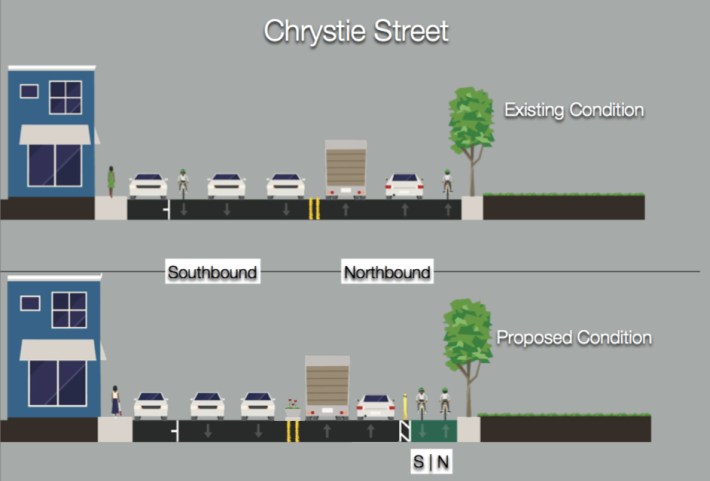
The community board covering the Lower East Side and Chinatown is set to ask DOT to transform the Chrystie Street bike lane from barely visible stripes blocked by double-parked cars into a two-way protected bikeway along Sara D. Roosevelt Park, connecting the Manhattan Bridge with the Second Avenue protected bike lane.
The transportation committee of Manhattan Community Board 3 voted unanimously Wednesday night to ask for the upgrades on the recommendation of Dave "Paco" Abraham and other Transportation Alternatives volunteers, who presented the idea last month [PDF]. The request is moving ahead now because Chrystie Street is scheduled for milling and paving this year, providing an opportunity to redesign the street.
DOT staff at Wednesday's meeting welcomed the resolution. "We are looking to resurface the road this year, so we will come back to the community once a design is put together," DOT Manhattan Liaison Colleen Chattergoon said.
At the southern end of Chrystie Street, the city is planning to rebuild the Manhattan Bridge bike path landing to include a pedestrian-friendly plaza space next to the bikeway. At Chrystie's northern end, advocates hope a two-way bikeway on the east side of the street can eliminate the need for southbound cyclists on Second Avenue to maneuver across multiple lanes of car traffic in order to continue southbound.

Between Canal and Houston, the two-way bikeway would only cross automobile traffic at Grand and Delancey Streets, since other cross streets in the neighborhood form "T" intersections and do not continue through the park. The two-way bikeway alignment could also create opportunities for pedestrian islands on the crowded street.
The redesign request is supported by the Sara D. Roosevelt Park Coalition. Kathleen Webster, the group's president, asked the committee to make sure the resolution noted the senior centers, schools, elderly population, and high pedestrian volumes in the area, including a senior center within the park itself. CB 3 District Manager Susan Stetzer asked the committee to request that DOT conduct community visioning sessions to inform the final design. Both requests were added to the resolution.
The resolution now goes to the full board, which meets on February 24 at 6:30 p.m. at P.S. 124, 40 Division Street.
The committee also considered a request from the Chinese Chamber of Commerce of New York to move the Citi Bike rack at Confucius Plaza to make room for a row of cherry trees. The chamber suggested moving the station to a nearby sidewalk or parking lane on Division Street, but DOT opposed moving the station and board members were also concerned that moving the station would in turn displace a commuter van drop-off zone on Division. The committee did not take up a resolution backing the chamber's request.
The committee unanimously supported a request from parents at P.S. 110, the Florence Nightingale School, for a DOT school safety study. The school is located on Delancey Street, just south of the Williamsburg Bridge and Baruch Houses, and is bounded by narrow Cannon and Broome Streets, which are often used by parents with cars for drop-off. “These roads are tiny, tiny little roads," said Chad Marlow, whose daughter is in kindergarten at the school. He hopes the streets could eventually be made car-free. “I think it would be wonderful if we did something before a kid got hurt.”
The Department of Design and Construction presented details of an already-approved Safe Routes to School project that will add five neckdowns at Strauss Square, which is bounded by Canal Street, Rutgers Street, and East Broadway near Seward Park [PDF]. Construction is set to begin this month and expected to be complete in the fall.





